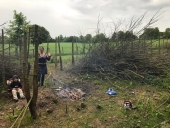Hi folks, I haven't seen many threads on here dedicated to the details of making biochar. I've played with it a bit and made some conclusions that suit my personal circumstances, but I was wondering if others had ended up following similar thought processes.
My biochar background...
I've been making and spreading biochar for about 6 years. We get a huge amount of woody waste from hedge trimming our ornamental gardens, and twiggy branch material left from processing firewood. Our biochar processing is primarily a waste disposal project, and getting a yeild of char is a useful perk but not usually the main aim. We
compost what we can, but still get lots of woody stuff. We aren't at a stage where hugelculture can work for us, so lots of mixed material gets dumped on burn piles.
55 Gallon Drum
I've tried this in various configurations, including TLUD and found it quite unsatisfactory. When dealing with large quantities of branch wood and hedge trimmings it takes far too long to cut and trim material down to a size suitable for stacking tightly in the drum. Typically I yielded about 10 gallons from a burn that might take 3 hours of processing start to finish. This quantity would barely dent my usual pile of material, so I would need to repeat the process half a dozen times to get done.
Open burn with a quench
Basically a bonfire, keep adding more material in layers, the char builds up at the bottom and doesn't burn away because the oxygen can't get to it. Quench it with water when you are done. I've had my biggest total yields from these burns, with really very minimal effort.
To my mind this has some nice advantages over the restricted size of the barrel burn. Material can be thrown on without trimming and cutting excessively. It seems to get hotter and keep it's heat well so can cope with green fresh cut material. The absolute yeild from the same set of fuel material is lower than with a barrel, but the time is so much quicker. Typically a 4 hour burn from start to finish, with a total yield that is much greater. Open burns can be quite smokey, but if managed carefully the smoke can be minimised.
Char making cook stove.
I've made a few versions of these, and used a commercial one. They work great for making small regular amounts from stick wood and, if your circumstances suited it you could make a reasonable amount as part of a simple routine with no extra work. I use them when catering for groups out of doors, including cooking for groups of 50+.
I have seen plenty of plans and videos for retort based systems. Most of them look like they would cost a fair amount to build (or have fabricated) and few look like they would be able to make good use of random branching brush wood. Most videos show people stacking a retort up with nice seasoned logs. Frankly every seasoned log I get ends up going in the wood burner to heat the house - I really don't see the value in making biochar from top notch firewood when it should be made from waste material. Ultimately I think a retort system will not be for me.
The 'Cone Kiln' looks promising. It has the benefits of the open fire (taking charges of any old size/shape with minimal processing) but improves on it a bit by using metal sides to contain and protect the char as it forms. You can carry on adding more and more fuel wood until the cone is full of char. It is simpler than a retort and should be fairly cheap to construct. I've seen a straight sided pyramid version as well, which can be made from flat sheet without bending. You can make a cone shape by digging a hole/building up sides, but our soil is pretty hard to dig - probably a good bet in lighter sandy soils.
So, what methods do you folks use?
What is your main fuel source?
How do you 'charge' your char?
Mike









